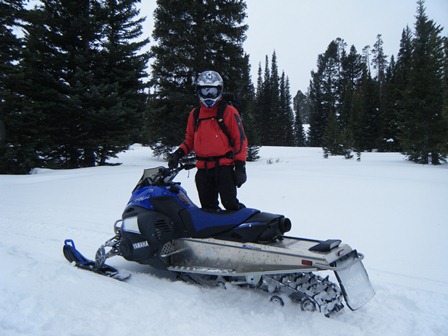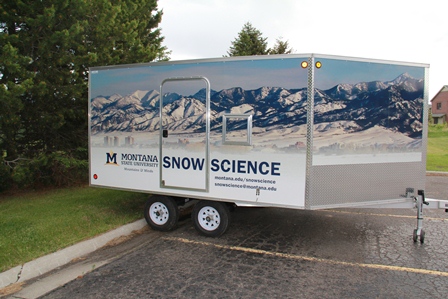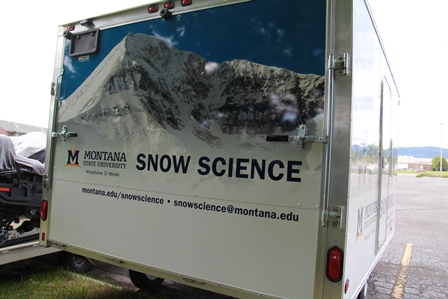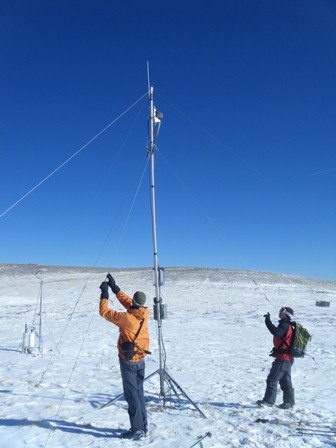Snow and Avalanche Lab
Overview

Jordy Hendrikx next to his mini-temperature & relative humidity sensor. 15 of these sensors have been deployed around the Yellowstone Club in SW Montana to assist in a project which aims to examine spatial variability of surface faceting and their associated meteorological variables.
The snow and avalanche lab is the home of snow science in the Department of Earth Sciences at Montana State University. The lab is a new purpose built graduate research space for snow and avalanche research and is under the direction of Dr Jordy Hendrikx. It is located in the south eastern corner of the Traphagen Building, Room 126, immediately below the main Earth Sciences office. While physically separate, we work in collaboration with the Engineering faculty in Civil Engineering and the Subzero facility.
We have a strong graduate program focused on snow, as both a resource and a hazard. We also offer an undergraduate degree in snow science, which includes several snow specific courses, including one with weekly snow based field lab classes (ERTH450 Snow Dynamics and Accumulation). This undergraduate degree is a strongly quantitative geo-science degree with an emphasis on snow science.
Our setting in Bozeman, Montana is an ideal natural laboratory, with four different ranges within an hour (some as close as 20 minutes), all of which can exhibit different snow characteristics. This is combined with good access, varied terrain and great snowfall. More information on the undergraduate snow science degree is available here.
A recent article in EARTH magazine profiles the long history of snow science in both the Department of Earth Sciences and the College of Engineering at Montana State University and the connections with the Forest Service Gallatin National Forest Avalanche Center.
Research
Our research focuses primarily on snow as a hazard and as a resource. Most of our work has a strong process based, observational, field component. We have graduate students working on projects related to the spatial variability of snow water equivalence through to the effect of explosives on the snowpack to understanding decision making in avalanche terrain. Please click on the links below to see what we are working on.
Helping set up an experimental laser
scanner installed by NCAR on a recent trip
up Niwot Ridge, Colorado.
Faculty
Current Graduate Students
- Gabrielle Antonioli (MSc)
- Matthew Hickey (MSc)
- Andrew Schauer (MSc)
- Erich Peitzsch (PhD)
- Lauren Yokley (MSc)
Co-supervised at other institutions:
Holt Hancock (PhD candidate), The University Centre in Svalabard (UNIS), Norway
Matthew Stephensen (PhD candidate), Center for Avalanche Research and Education (CARE), University of Tromsø (UiT), Norway
Recently Finished Graduate Students
- John Sykes (MSc, 2018)
- Diana Saly (MSc, 2018)
- Ryan Scanlon (MSc, 2017)
- Kyle Van Peursem (MSc, 2016)
- Holt Hancock (MSc, 2016)
- Tom Matthews (MSc, 2015)
- Matt Wieland (MSc, 2015)
- Jason Welz (MSc, 2015)
- Ian Hoyer (MSc, 2014)
- Matt Borish (Msc, 2014)
- Alex Marienthal (MSc, 2014)
- Karl Wetlaufer (MSc, 2013)
- Robyn Wooldridge (MSc, 2013)
Equipment
The lab is equipped with:
- Basic snow safety equipment (e.g. Shovels /probes / transceivers etc.)
- Specialized snow science equipment (e.g. Shear Frames / Density cutters / Federal Samplers)
- Hand held & survey grade GPS units (2x Trimble GeoXh)
- Two UAVs (Phantom 4 Pro)
- 25 compact RH and Temp sensors
- Two fully portable remote weather stations including full 4 component radiation balance
- Steam drill and Kovacs augers
- Two Snowmobiles (2 x Yamaha Nytro)
- A tandem box trailer
- A 4x4 field vehicle (Ford Explorer)
- A purpose built storage and drying facility
- A modeling / GIS computer (Updated in 2018)
- A large format printer
- Easy access to several different mountain ranges with world class snow and terrain for field based studies
Opportunities
Each year we accept applications for new graduate students. The deadline is 15 January of that year. More details about the graduate application process can be found here. Interested students are encouraged to contact Dr. Jordy Hendrikx to discuss their ideas before submitting an application. Please email him at [email protected]

Jordy Hendrikx on one of the Snow and Avalanche Laboratory's
Yamaha Nytro snowmobiles on a recent trip up Buck Ridge, Big Sky, MT

Starting out on a day in the field at Lionhead, near
West Yellowstone, MT.
New Resources
The ISSW Proceedings database project was a joint development effort of Montana State University Library Digital Collections and the ISSW Steering Committee. MSU has recently made the Proceedings of the International Snow Science Workshops (ISSW) available electronically. Additional funding for the Project was provided by the Canadian Avalanche Association and the American Avalanche Association. The ISSW Proceedings Project objective was to find, convert to pdf, compile, and then deliver online all previous years of the ISSW Proceedings and then add proceedings from future ISSW Workshops.
The ISSW Proceedings Project was started in 2010 with the papers from the ISSW 2008 Whistler, BC, Canadian Workshop. During 2011 and 2012 the ISSW Proceedings papers from 1976 through 2010 were added. These were again updated to include the 2010 - 2016 proceedings.
New Trailer Gets a Face Lift
To protect our two new snow mobiles (Yamaha Nytro's) and to raise awareness of the snow science program and MSU, we have had our new tandem-axle snowmobile trailer "wrapped" by local experts SCS Wraps (link to: http://scswraps.com/). The MSU design team and SCS Wraps have done a great job of using two of our local mountain ranges - the Bridger Range, which is on our doorstep, and Lone Peak, Big Sky, which we frequently visit as part of our teaching and research field work.


Past Graduate Students from the Snow Science Program
Matt Wieland (MS, 2015)
The Influence of forest on the distribution and size of surface hoar in small meadows
He is currently working as an Avalanche Forecaster for the Sawtooth Avalanche Center.
Jay Welz (MS, 2015)
Understanding the spatial distribution of snow water equivalent in paired basins in Southwest Montana.
He is currently working as a Hydrologic Technician for the the USDA-NRCS Snow Survey and Water Supply Forecasting Program in Colorado.
Ian Hoyer (MS, 2014)
An investigation of the spatial variability and efficacy of the Extended Column Test
He is currently working as an Avalanche Forecaster for the Colorado Avalanche Information Center (CAIC) in Leadville, CO.
Matt Borish (MS, 2014)
Surface hoar observations at the scale of a helicopter skiing operation.
He is currently working as the Advanced LiDAR Classification Division Lead at Quantum Spatial in Portland, OR.
Alex Marienthal (MS, 2014)
Meteorological metrics associated with deep slab avalanches on persistent weak layers.
He is currently working as an Avalanche Forecaster for the Gallatin National Forest Avalanche Center (GNFAC) in Bozeman, MT.
Karl Wetlaufer (MS, 2013)
He is currently working as a Hydrologist for the USDA-NRCS Snow Survey and Water Supply Forecasting Program in Denver, CO
Robyn Wooldridge (MS, 2013)
The effects of Explosives on the Physical Properties of Snow.
She is currently working as an Adjunct in the Department of Earth Sciences at Montana State University.
Zach Guy (MS, 2011)
He is currently working as the Director of the Crested Butte Avalanche Center and a guide for Irwin and Crested Butte Mountain Guides in Crested Butte, CO .
Tara Chesley-Preston (MS 2010)
She is currently a GIS Analyst with the City of Bozeman, MT.
Eric Lutz (PhD 2009)
He is currently a Postdoctoral Research Associate in the Glaciology Research Group of the Department of Earth Sciences at Dartmouth College.
Erich Peitzsch (MS 2009)
Water movement in a stratified and inclined snowpack: Implications for wet slab avalanches.
He is currently the Director of the Flathead Avalanche Center and a physical scientist with the USGS Northern Rocky Mountain Science Center in Glacier, MT.
Mike Cooperstein (MS 2008)
He is currently the owner/operator of Montana Alpine Guides.
Simon Trautman (MS 2007)
Wet loose snow avalanching in southwestern Montana.
He is currently the National Avalanche Specialist with the Forest Service National Avalanche Center.
Spencer Logan (MS, 2005)
He is currently an avalanche forecaster with the Colorado Avalanche Information Center.
Chris McCollister (MS, 2004)
Geographic knowledge discovery techniques for exploring historical weather and avalanche data.
He is currently an avalanche forecaster for the Bridger-Teton National Forest Avalanche Center and a consultant for an infrasonic avalanche detection project.
Jeanette Romig (MS, 2004)
March wet avalanche prediction at Bridger Bowl Ski Area
She is currently an environmental consultant for Oasis Environmental in Livingston, Montana.
Jeff Deems (MS, 2003)
He is currently a Research Scientist at the National Snow & Ice Data Center.
Chris Landry, (MS, 2002)
He is currently the director of the Center for Snow and Avalanche Science in Silverton, Colorado.

